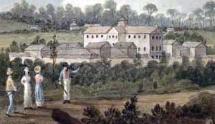
Female Factory, watercolour, Augusts Earle, 1826
On November 14th 2017, the Parramatta Female Factory and Institutions Precinct was included in the National Heritage List under the Environment Protection and Biodiversity Conservation Act 1999. Its outstanding heritage value to the nation has been recognised because of the place’s:
- importance in the course, or pattern, of Australia’s natural or cultural history
- possession of uncommon, rare or endangered aspects of Australia’s natural or cultural history
- potential to yield information that will contribute to an understanding of Australia’s natural or cultural history.
Read more about this extraordinary site and what the Parra Girls have achieved for Australia.
NAME: Parramatta Female Factory and Institutions Precinct
BOUNDARY:
Approximately 7.3ha, Fleet Street, North Parramatta, comprising the following areas:
1) The whole of land parcels Lots 1 & 2 DP862127; and
2) That part of land parcel Lot 3 DP808447 bounded by a line commencing at the intersection of the eastern boundary of land parcel Lot 3 DP808447 with the road centreline of Greenup Drive (approximate MGA point Zone 56 314987mE 6257888mN), then southerly, westerly, generally south westerly and north westerly via the eastern, southern and western boundaries of land parcel Lot 3 DP808447 to the intersection with MGA northing 6257809mN (approximate MGA point 314801mE 6257809mN), then north westerly directly to the intersection of the eastern bank of the Parramatta River with MGA northing 6257813mN (approximate MGA point 314797mE 6257813mN), then north westerly via the eastern bank of the Parramatta River to its intersection with MGA northing 6257906mN (approximate MGA point 314660mE 6257906mN), then north westerly directly to the intersection of the road centreline of River Road with the road centreline of Warrinya Avenue (approximate MGA point 314718mE 6257952mN), then north easterly via the road centreline of River Road to its intersection with the road centreline of Eastern Circuit (approximate MGA point 314852mE 6258039mN), then south easterly via the road centreline of Eastern Circuit to its intersection with the road centreline of Greenup Drive (approximate MGA point 314892mE 6258019mN), then southerly and south easterly via the road centreline of Greenup Drive to the commencement point.
| Criterion | Values | |
| (a)
|
the place has outstanding heritage value to the nation because of the place’s importance in the course, or pattern, of Australia’s natural or cultural history. | The Parramatta Female Factory and Institutions Precinct is outstanding in its capacity to tell the stories of women and children in institutions over the course of Australian history. The Precinct demonstrates how colonial and state governments chose to address the perceived problem of vulnerable women and children, who they regarded as needing protection and control, through the use of institutions as a core element of the welfare system. In particular the Precinct provides a record of the experiences of convict women, and of how women and children as a class had a distinct experience of “benevolent” institutions, where the purpose and promise of care was far from the reality. Women living without the oversight of a husband or family were subject to moral judgment. Authorities saw it as necessary to step in as decision-maker and moral guardian, both of the women and of their children, who were seen as vulnerable to the consequences of poor parenting. Parramatta Female Factory and Institutions Precinct demonstrates how institutionalisation allowed for this duality of care and control to be enacted in a carefully administered environment. The legacy of penal approaches to caring for women and children, initiated in the Female Factory, persisted throughout the life of the Precinct in the way in which children’s lives were regulated in the Orphan and Girls Schools. Over one hundred and fifty years the experiences, treatment and prejudices towards the women of the Female Factory, children of the Roman Catholic Orphan School and girls of the Industrial School, including Indigenous children of the Stolen generations, showed a consistent theme of attempts at care limited by paternalism and poor treatment. The Precinct reveals the physical form which institutions took from the 19th to the 21st centuries. This in turn reflects the approaches to care that existed over the historical period, as well as providing a focal point for the stories of institutionalised women and children This value is expressed in the remaining physical fabric of the Parramatta Female Factory (North-East and South-East Ranges, Penitentiary Sleeping Ward and remaining walls) and Roman Catholic Orphan School and Girls Industrial School (Main Administration Building, Covered Way, South- West Range, Chapel, Laundry, Bethel House and the Gatehouse), also known as the former Norma Parker Centre/Kamballa Site. This includes both the exterior and interior original fabric of the buildings and the curtilage they sit within, including but not limited to: the form of the South-West Range with its long, narrow, attic dormitory spaces; Female Factory, Orphan and Girls School site walls; enclosed courtyard and assembly spaces created by the South-West Range, Covered Way and fences; the Female Factory clock as used in Ward 1 of the Institute of Psychiatry; the relationship of the Orphan and Girls Schools with the wall of the Parramatta Female Factory, reinforcing the institutional qualities of the Schools; the perimeter wall of the Girls School, and the pairing of the Female Factory South-East and North-East Range. The values are not expressed in later intrusive additions to the original fabric.
|
| (b) | the place has outstanding heritage value to the nation because of the place’s possession of uncommon, rare or endangered aspects of Australia’s natural or cultural history | The Parramatta Female Factory is a rare surviving example of its type in Australia. Female factories are rare sites; while there are a variation of sites associated with male convicts, such as gaols, probation stations, mines and convict-built infrastructure, there were fewer sites associated with convict women. In addition, there are few of these sites left. Nine of the 12 female factories which existed in colonial Australia are completely demolished. Places associated with the female experience of convictism are therefore rare. Parramatta Female Factory and Institutions Precinct demonstrates the nature of female convicts’ experiences, and indicates social attitudes at the time to how these women should be managed. The existence of original buildings and walls on the Parramatta Female Factory site, their significance as a marker of the conditions and experiences of female convicts, and their national rarity mean the original Female Factory buildings are of outstanding value to the nation under this criterion. This value is expressed in the remaining physical fabric of the Parramatta Female Factory, being the North-East and South-East Ranges, Penitentiary Sleeping Ward and remaining walls. |
| (c) | the place has outstanding heritage value to the nation because of the place’s potential to yield information that will contribute to an understanding of Australia’s natural or cultural history | The Parramatta Female Factory and Institutions Precinct has outstanding potential to yield information that will contribute to an understanding of the lives of convict women in early colonial Australia, in particular their lives in institutions. The remnant built fabric relating to the Parramatta Female Factory is significant and further archaeological study of the area has the potential for finds of equal significance within the original boundaries of the Female Factory site, both of built fabric and of artefacts which reveal information about the daily lives of convict women. This value is expressed by the remnant built fabric and archaeological evidence found within the place relating to the original area of Parramatta Female Factory. The potential archaeological site covers the area which is encompassed by the Parramatta River, River Road, Eastern Circuit, Greenup Drive and Fleet Street, cutting west from Fleet Street back to the Parramatta River along the southern boundary of Lot 3 DP808446, which reflects the original Female Factory site. This area contains known and likely areas of archaeological potential, especially the hidden, lost and discarded artefacts of convict women, in addition to the remaining three buildings (North-East and South-East Ranges and Sleep Ward), the physical remnants of demolished Female Factory Buildings including the North-West Range and potential remaining features such as wells and wall footings. |
| Environment Protection and Biodiversity Conservation Act 1999
INCLUSION IN THE NATIONAL HERITAGE LIST OF PARRAMATTA FEMALE FACTORY AND INSTITUTIONS PRECINCT I, Josh Frydenberg, Minister for the Environment and Energy, having considered in relation to the place and the National Heritage values described in the Schedule of this instrument: (a) the Australian Heritage Council’s assessment whether the place meets any of the National Heritage criteria; and (b) the comments given to the Council under sections 324JG and 324JH of the Environment Protection and Biodiversity Conservation Act 1999; and being satisfied that the place described in the Schedule has the National Heritage values specified in the Schedule, pursuant to section 324JJ of the Environment Protection and Biodiversity Conservation Act 1999, include the place and the specified National Heritage values in the National Heritage List. Dated 10/11/2017 [signed] Josh Frydenberg Minister for the Environment and Energy |

Leave A Comment